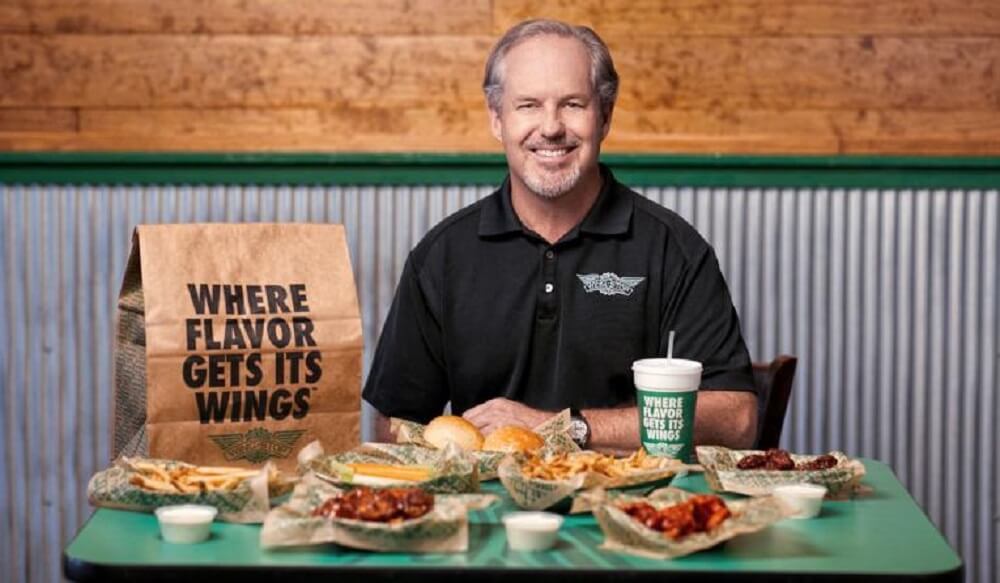Charlie Morrison | CEO, Winstop
Mid-March of 2020 will forever be seen as the point at which life fundamentally changed, especially for the restaurant industry. For the leadership team at Dallas-based Wingstop, it wasn’t just a stressful period of communicating with franchisees, assembling a COVID taskforce, implementing new sanitation measures, and shuttering the company’s headquarters. It was also a moment of truth. The brand’s big bets on high-tech innovations to power its fairly simple business of serving chicken wings, fries, and drinks were about to be put to the test.
Those bets were placed by Charlie Morrison, Wingstop’s CEO. Since arriving in 2012, he’d implemented a strategy centered on making access to the company easier for guests, primarily through new ordering solutions. “Quite frankly, if we didn’t provide that efficiency and that access, we may not be as successful as we are,” he says. “And I think the pandemic has proven that, for our brand in particular; it was available, it was understood and well known, and it was easy to adapt to. Whereas some other brands were not as ready or as advanced, and so it’s been a challenge to catch up on the curve.”
The pandemic has proven that and then some. In a season when industry sales are contracting by hundreds of billions of dollars, Wingstop reported domestic same-store sales gains of over 25 percent for 2020’s third quarter. The big bets have paid off handsomely. And even more than in prior years, Wingstop has become the model of what is possible in the limited-service industry.
THE BUILDING BLOCKS
While nobody could have predicted that a pandemic would drastically reshuffle the restaurant industry this year, it quickly became apparent that the so-called winners of the COVID-19 crisis were those that had already invested in digital ordering and a robust off-premises strategy.
Indeed, Wingstop seemed almost prophetic for already working toward a goal of having 100 percent of its sales be placed digitally. That work started when Morrison came over to the company from RAVE Restaurant Group—parent to Pizza Inn and Pie Five—in 2012. At the time, he says, Wingstop was strong in executing its operation, but lacked discipline in areas like marketing, supply chain, and technology—“fundamental building blocks,” he says, that were necessary to scaling the concept aggressively.
“When I first got to the brand, we actually had an online ordering mechanism,” he says. “It was poorly and loosely constructed, as you could imagine, but it worked. You had an app, you could go on your phone, you could order wings. But that was where the technology stopped and the analog process began.”
It was then that Morrison’s experience in the pizza category became an advantage, as he says he recognized the opportunity to simplify that ordering process. And simplification started with consistency across the system so that the company’s franchisees—“brand partners”—could be on the same page and trust that the investments would be sound. So Wingstop standardized its POS system and its menu, then rolled out an integrated, enterprise-grade online-ordering system.

Stacy Peterson, Wingstop’s chief technology officer, says these fundamental technology tools gave the brand partners the confidence they needed to believe in the power of online ordering. “It wasn’t until the brand partners could rely on the systems that we put in place [that] they started promoting it to their guests,” she says. “And once they started promoting it to our guests, we saw our digital adoption increase, and we increased organically every year [by] 4 or 5 percent year over year.”
Wingstop has since doubled down on digital ordering capabilities; guests today can order via the company’s app or website, as well as via DoorDash. By early March, Wingstop’s digital mix was about 40 percent of sales; the pandemic has since pushed it to over 60 percent, which Morrison says is two years ahead of schedule.
Because all of these digital orders are integrated into the back end, Peterson says, it eliminates any complexities for the brand partners. “If they bring it up with the guest standing in front of them, or the guest is on a myriad of accessible channels where they could place their order, they all come in the exact same way, exact same ticket, exact same make line,” she says.
The benefits of these digital solutions were evident: Not only did they streamline operations, but they also boosted the top line. Average checks for digital orders are $5 higher than those through non-digital channels.
AN UNFAIR ADVANTAGE
The COVID-19 outbreak forced one word into every restaurant operator’s everyday lexicon: pivot. Brands had to scramble to adopt contactless operations, enhance store sanitation, and roll out additional access points to keep sales flowing.
But at Wingstop, no grand pivot was necessary; the tech stack already ensured efficient digital ordering, and business was about 80 percent off-premises even before the word coronavirus became a household term. Mahesh Sadarangani, Wingstop’s COO, says the company chose to close dining rooms before it was mandated by legislation, ensured stringent sanitation measures, invested in employee safety strategies, and implemented additional precautions like tamper-evident stickers to its delivery packaging.
Messaging became another area that demanded a quick pivot across the industry. Many restaurant companies—especially wing and pizza brands—were heavily marketing March Madness, which was only days away from starting when COVID-19 grounded public activities to a halt. And the fact that, early in the pandemic, there was a lot of uncertainty around how COVID-19 spread, companies had to communicate with guests in such a way that gave them confidence in the experience.
Christina Clarke, CMO, says that even in messaging, there was no need for Wingstop to make sweeping changes. She says the brand had already tailored its messaging to the fact that wings are very social but also highly individualized; Wingstop’s 11 flavors allowed for menu personalization, and its combo meals helped make wings more of a center-of-the-plate item rather than just a shareable. The company had filmed commercials in late 2019, she says, that focused on online ordering, delivery, and bringing families together with variety—three favorable messages for the quarantine era—and once the pandemic hit, the objective became showing up where consumers were.
“We saw where the eyeballs were going. … They were going to streaming, they were going to digital, online activities,” Clarke says. “And that’s exactly where we moved our messaging and made some minor modifications to make sure that delivery was coming through loud and clear, as it was originally intended.” That included free-delivery promotions early in the pandemic, and digital campaigns like the 24-hour virtual DJ festival it hosted on National Chicken Wing Day, July 29.
Of course, pivoting couldn’t staunch the hemorrhaging sales at most restaurants. Industry sales dropped precipitously once dining rooms closed, and at many brands, they still haven’t recovered. Those companies that were able to quickly rebound were the ones that regained customer trust and offered a seamless and safe ordering experience—an unfair advantage for 26-year-old Wingstop.
“We had created a trustworthy platform for our guests to enjoy our product without having to come into the restaurants,” Morrison says. “That’s built over a long period of time, and developing that trust is really important. If you look at a lot of consumer research that’s been done since the pandemic started, the things that are now most important to consumers are trustworthy brands.”
BUILDING TRUST
Developing that trust isn’t something that happened by accident. Morrison credits Wingstop’s core values—being service-minded, authentic, fun, and entrepreneurial—for guiding the brand’s decisions during the COVID-19 crisis.
Donnie Upshaw is Wingstop’s senior vice president of people, tasked with building and maintaining that bond that the wings brand has established with its 241 corporate team members and about 300 brand partners who own all but 31 of the 1,450-plus worldwide locations. “From a cultural perspective, the fun that you see, the entrepreneurial spirit, the service mindedness, all those things come to life in different ways based on your role,” he says. “But every single team member is held to that accountability to live our values.”
In normal times, Wingstop invests in its corporate team through opportunities for advancement, unlimited paid time off, participation in community outreach, and all-hands meetings that Upshaw says prevent the “NETMA” problem (“nobody ever tells me anything”).
As it has for most businesses, the pandemic has forced Wingstop to get more creative with its corporate outreach, as the headquarters is closed and the team is working from home. Wingstop gave employees a stipend to set up a home office, allowed for flexible schedules so they could navigate around home issues, and hosted weekly all-hands calls via Zoom.
The pandemic wasn’t the only crisis to stress-test the culture in 2020; so, too, did the murder of George Floyd in Minneapolis in May and the proceeding Black Lives Matter protests across the country. Upshaw says the company recognized the role it needed to play for its diverse team, and it wasn’t just to offer thoughts and prayers.
“We can’t just write a check and we can’t just send out a tweet. We have to make this scalable. We have to make this impact be felt across our 1,400-plus restaurants,” he says. “We can’t just be cool when it’s convenient. And I think that is one thing that we’re learning through all of this: It is going to be hard. It’s heavy lifting, but it is our responsibility.”
To start, Wingstop chose to listen to its employees. While the team usually stays on mute during the weekly all-hands videos, Morrison says he invited the more than 250 people on a call in late May to unmute so they could voice their feelings—a “raw” and “highly emotional” experience, he says. From there, Wingstop created a task force charged with creating actionable insights for the entire system.
“We as leaders are given the responsibility and the authority to make decisions and do things that can impact not only our organizations, but the world around us,” Morrison says. “What we need to do is listen, open the conversation with our people. As a white man, I don’t understand everything that a Black person goes through in this world today, but I want to learn and understand that so that I can affect change in whatever way I can.”

NEW OPPORTUNITIES
If all goes according to plan, Wingstop will have plenty of opportunity to affect the world around it. At the close of Q3, the company had 1,479 locations, 1,308 of which were domestic. In its ambitions to become a top 10 global restaurant brand, Wingstop hopes to have 3,000 units in the states and another 3,000 overseas.
Where many brands slammed the brakes on expansion during the pandemic, Wingstop has managed to plow ahead with its store openings, even if projections for the year have been scaled back just a bit. The brand opened 28 net new locations in Q1, 23 in Q2, and 43 in Q3, and Madison Jobe, Wingstop’s chief development officer, says momentum continues to build for brand partners looking for expansion opportunities, particularly as vacancy rates go up. Some 80–90 percent of domestic development is with existing partners, he adds.
Jobe says one silver lining to the pandemic has been the company’s ability to quickly jump through hoops in permitting. “We have municipalities that, a year ago, it might have taken us 90 or 120 days to get a permit, and now we’re getting it in 30 or 45 days because of the lack of demand for that particular part of what a city or county provides in permits,” he says.
In conjunction with traditional store openings, Wingstop is exploring new opportunities like ghost kitchens. It opened its first ghost-kitchen operation in Dallas in June, and Morrison says he sees them working very well for urban locations like New York City, San Francisco, and Chicago. CTO Peterson says Wingstop was also working on ordering kiosks and pickup lockers before the pandemic, but has put those tests on hold for now.
As for drive thru, that’s likely not in the cards unless it’s a pickup window for digital orders. COO Sadarangani says he’s seen the new prototypes introduced by brands like Burger King and Shake Shack, but doesn’t believe that kind of evolution is necessary for Wingstop.
“What does that restaurant of the future look like? For us, I would say we’re in it. I’m not tempted by what all these other restaurants are doing, like the drive-thru lanes,” he says. “We’re in that category of one. We were set up nicely with our digital business prior to the pandemic, and that only accelerated. So I feel like others are playing catch-up while we’re just continuing to operate and execute our plan as we had in place well ahead of the pandemic.”
Indeed, having such a great position in the market today has given Wingstop the luxury of focusing on another key strategy for growth: international expansion. Since it’s targeting 6,000 total locations and half of them overseas, most of the growth ahead of it will be in international markets. Morrison says Wingstop’s potential globally is limitless; chicken is the No. 1 protein in the world, he says, and even though Americans prefer boneless chicken breast, the rest of the world opts for bone-in chicken. Already the concept has thrived in Mexico, where it has nearly 100 locations, and Indonesia, where it has more than 30.
“We are a highly entrepreneurial brand,” says Marisa Carona, vice president of strategy and chief of staff for Wingstop. “So even as we continue to grow rapidly and in size, as well as our average unit volumes, we maintain a lot of our entrepreneurial roots, and that allows us to act swiftly, act with decision.”
Nicolas Boudet, Wingstop’s president of international, says that in the next five to 10 years, Wingstop’s international growth will be very precise and focus on markets where digital sales and off-premises business are very strong, like in Western Europe.
“We found that we operate better in what we call a developed type of economy, where there is that higher disposable income from the consumer side, where the ability to operate a small concept or concept that is very efficient and very focused around chicken wings allows us to not have to have a significant labor pool for us to be able to operate stores,” he says.
INTENTIONALLY AGILE
In a year when there’s been so much upheaval in the restaurant industry, you’d be forgiven for thinking Wingstop wasn’t experiencing the same global pandemic as the rest of us. COVID-19 didn’t slow it down on its crash course to becoming a top 10 global brand, but in fact may have sped it up.
Still, the company isn’t resting on its laurels. Morrison says there’s a commonly held theory in the restaurant industry that at 2,000 locations, there’s a chasm the company must cross, and in crossing that chasm, the company either creates a sustainable platform for long-term success or starts to make mistakes. With that milestone in spitting distance, he says, the company is doing several things in preparation.
“One is continuing to invest in our team and our people to make sure that we have the resources, the people, the infrastructure we need to be able to cross that chasm effectively,” he says. “Second, even though we’ve built a very robust technology platform, we still believe there is a way to make it even more scalable so that it becomes a global platform.”
It’s one of those core values that should help Wingstop along the way: being entrepreneurial. The company hopes that even as it gets bigger, it can maintain the ability of being “intentionally agile, not reactively agile,” as CMO Clarke puts it.
“We are a highly entrepreneurial brand,” says Marisa Carona, vice president of strategy and chief of staff for Wingstop. “So even as we continue to grow rapidly and in size, as well as our average unit volumes, we maintain a lot of our entrepreneurial roots, and that allows us to act swiftly, act with decision. Entrepreneurs often have to navigate unknown territory and uncharted waters, and that’s certainly served us well during the pandemic.”
Technology is clearly one field where Wingstop asserts that entrepreneurialism. And CTO Peterson says the company will continue to push the envelope with technological innovations; no matter if new innovations work or don’t work, she says, the company will learn something from it. As an example, in its quest to make 100 percent of transactions digital, Wingstop has tested automated voice orders by phone using natural language processing.
“The first time we did it, we weren’t happy with the results, so it never came out of test, and we kind of put that on the shelf for a little bit,” she says. “And now we’re back at it again, and we have it running in about half of our corporate restaurants. We’re much more encouraged by where the technology has progressed since our first time.”
Surely everyone is happy with the bigger results that Wingstop is seeing during the COVID-19 pandemic. The crisis has validated eight years’ worth of work and supercharged its path toward achieving its goal.
But Morrison isn’t ready to take his foot off the accelerator just yet.
“It was nice for us to have a head start, but if we want to maintain that leadership position, then we’ve got to continue to enhance our platform and be out on the leading edge and making sure that we have the best guest experience possible,” he says. “There’s always competition out there. While we don’t feel like we have a direct competitor in the product we sell, we have a lot of competition just in terms of the choices that are out there for consumers. And so we’re always going to stay on top of it.”










